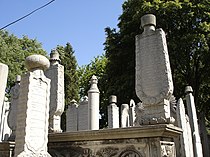Funerary art
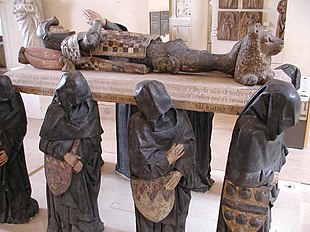


Funerary art is any work of art forming, or placed in, a repository for the remains of the
The deposit of objects with an apparent aesthetic intention is found in almost all cultures –
An important factor in the development of traditions of funerary art is the division between what was intended to be visible to visitors or the public after completion of the
Terminology
Tomb is a general term for any repository for human remains, while grave goods are other objects which have been placed within the tomb.[2] Such objects may include the personal possessions of the deceased, objects specially created for the burial, or miniature versions of things believed to be needed in an afterlife. Knowledge of many non-literate cultures is drawn largely from these sources.
A
The word "funerary" strictly means "of or pertaining to a funeral or burial",[4] but there is a long tradition in English of applying it not only to the practices and artefacts directly associated with funeral rites, but also to a wider range of more permanent memorials to the dead. Particularly influential in this regard was John Weever's Ancient Funerall Monuments (1631), the first full-length book to be dedicated to the subject of tomb memorials and epitaphs. More recently, some scholars have challenged the usage: Phillip Lindley, for example, makes a point of referring to "tomb monuments", saying "I have avoided using the term 'funeral monuments' because funeral effigies were, in the Middle Ages, temporary products, made as substitutes for the encoffined corpse for use during the funeral ceremonies".[5] Others, however, have found this distinction "rather pedantic".[6]
Related genres of commemorative art for the dead take many forms, such as the moai figures of Easter Island, apparently a type of sculpted ancestor portrait, though hardly individualized.[7] These are common in cultures as diverse as Ancient Rome and China, in both of which they are kept in the houses of the descendants, rather than being buried.[8] Many cultures have psychopomp figures, such as the Greek Hermes and Etruscan Charun, who help conduct the spirits of the dead into the afterlife.
History
Pre-history
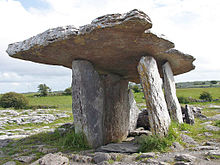
Most of humanity's oldest known archaeological constructions are tombs.
In
Ancient Egypt and Nubia

Egyptian funerary art was inseparable to the religious belief that life continued after death and that "death is a mere phase of life".[14] Aesthetic objects and images connected with this belief were partially intended to preserve material goods, wealth and status for the journey between this life and the next,[15] and to "commemorate the life of the tomb owner ... depict performance of the burial rites, and in general present an environment that would be conducive to the tomb owner's rebirth."[16] In this context are the Egyptian mummies encased in one or more layers of decorated coffin, and the canopic jars preserving internal organs. A special category of Ancient Egyptian funerary texts clarify the purposes of the burial customs. The early mastaba type of tomb had a sealed underground burial chamber but an offering-chamber on the ground level for visits by the living, a pattern repeated in later types of tomb. A Ka statue effigy of the deceased might be walled up in a serdab connected to the offering chamber by vents that allowed the smell of incense to reach the effigy.[17] The walls of important tomb-chambers and offering chambers were heavily decorated with reliefs in stone or sometimes wood, or paintings, depicting religious scenes, portraits of the deceased, and at some periods vivid images of everyday life, depicting the afterlife. The chamber decoration usually centred on a "false door", through which only the soul of the deceased could pass, to receive the offerings left by the living.[18]
Architectural works such as the massive
Lower-class citizens used common forms of funerary art—including
Ancient Greece
During the Iron Age, the ancient Greeks did not generally leave elaborate grave goods, except for a
Early Greek burials were frequently marked above ground by a large piece of pottery, and remains were also buried in urns. Pottery continued to be used extensively inside tombs and graves throughout the classical period.
The extension of the Greek world after the conquests of
Etruscans
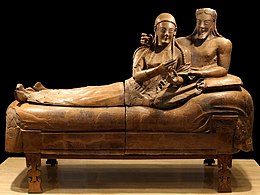
Objects connected with death, in particular
The main subject in the funerary art of the 7th and 6th centuries BCE was typically a feasting scene, sometimes with dancers and musicians, or athletic competitions. Household bowls, cups, and pitchers are sometimes found in the graves, along with food such as eggs, pomegranates, honey, grapes and olives for use in the afterlife.[38][39] From the 5th century, the mood changed to more sombre scenes of parting, where the deceased are shown leaving their loved ones,[40] often surrounded by underworld demons, and psychopomps, such as Charun or the winged female Vanth. The underworld figures are sometimes depicted as gesturing impatiently for a human to be taken away.[41] The handshake was another common motif, as the dead took leave of the living.[41] This often took place in front of or near a closed double doorway, presumably the portal to the underworld. Evidence in some art, however, suggests that the "handshake took place at the other end of the journey, and represents the dead being greeted in the Underworld".[41]
Ancient Rome

The burial customs of the
In later periods, life-size sculptures of the deceased reclining as though at a meal or social gathering are found, a common Etruscan style. Family tombs for the grandest late Roman families, like the Tomb of the Scipios, were large mausoleums with facilities for visits by the living, including kitchens and bedrooms. The Castel Sant'Angelo, built for Hadrian, was later converted into a fortress. Compared to the Etruscans, though, there was less emphasis on provision of a lifestyle for the deceased, although paintings of useful objects or pleasant activities, like hunting, are seen.[46] Ancestor portraits, usually in the form of wax masks, were kept in the home, apparently often in little cupboards,[47] although grand patrician families kept theirs on display in the atrium. They were worn in the funeral processions of members of the family by persons wearing appropriate costume for the figure represented, as described by Pliny the Elder and Polybius. Pliny also describes the custom of having a bust-portrait of an ancestor painted on a round bronze shield (clipeus), and having it hung in a temple or other public place. No examples of either type have survived.[48]
By the late
In Italy, sarcophagi were mostly intended to be set against the wall of the tomb, and only decorated on three sides, in contrast to the free-standing styles of Greece and the Eastern Empire. The relief scenes of Hellenistic art became even more densely crowded in later Roman sarcophagi, as for example in the 2nd-century Portonaccio sarcophagus, and various styles and forms emerged, such as the columnar type with an "architectural background of columns and niches for its figures".[50] A well-known Early Christian example is the Sarcophagus of Junius Bassus, used for an important new convert who died in 359. Many sarcophagi from leading centres were exported around the Empire.[51] The Romans had already developed the expression of religious and philosophical ideas in narrative scenes from Greek mythology, treated allegorically;[52] they later transferred this habit to Christian ideas, using biblical scenes.[53]
China
Funerary art varied greatly across Chinese history. Tombs of early rulers rival the ancient Egyptians for complexity and value of grave goods, and have been similarly pillaged over the centuries by
The discovery in 1974 of the

Tang dynasty tomb figures, in "three-colour" sancai glazes or overglaze paint, show a wide range of servants, entertainers, animals and fierce tomb guardians between about 12 and 120 cm high, and were arranged around the tomb, often in niches along the sloping access path to the underground chamber.
Chinese imperial tombs are typically approached by a "
The Goguryeo tombs, from a kingdom of the 5th to 7th centuries which included modern Korea, are especially rich in paintings. Only one of the Imperial Tombs of the Ming and Qing Dynasties has been excavated, in 1956, with such disastrous results for the conservation of the thousands of objects found, that subsequently the policy is to leave them undisturbed.[57]
The Lei Cheng Uk Han Tomb Museum in Hong Kong displays a far humbler middle-class Han dynasty tomb, and the mid-2nd-century Wu Family tombs of Jiaxiang County, Shandong are the most important group of commoner tombs for funerary stones.[58] The walls of both the offering and burial chambers of tombs of commoners from the Han period may be decorated with stone slabs carved or engraved in very low relief with crowded and varied scenes, which are now the main indication of the style of the lost palace frescoes of the period. A cheaper option was to use large clay tiles which were carved or impressed before firing.[59] After the introduction of Buddhism, carved "funerary couches" featured similar scenes, now mostly religious.[60] During the Han dynasty, miniature ceramic models of buildings were often made to accompany the deceased in the graves; to them is owed much of what is known of ancient Chinese architecture. Later, during the Six Dynasties, sculptural miniatures depicting buildings, monuments, people and animals adorned the tops of the hunping funerary vessels.[61] The outsides of tombs often featured monumental brick or stone-carved pillar-gates (que 闕); an example from 121 CE appears to be the earliest surviving Chinese architectural structure standing above ground.[62] Tombs of the Tang dynasty (618–907) are often rich in glazed pottery figurines of horses, servants and other subjects, whose forceful and free style is greatly admired today. The tomb art reached its peak in the Song and Jin periods; most spectacular tombs were built by rich commoners.[63]
Early burial customs show a strong belief in an afterlife and a spirit path to it that needed facilitating. Funerals and memorials were also an opportunity to reaffirm such important cultural values as filial piety and "the honor and respect due to seniors, the duties incumbent on juniors"[64] The common Chinese funerary symbol of a woman in the door may represent a "basic male fantasy of an elysian afterlife with no restrictions: in all the doorways of the houses stand available women looking for newcomers to welcome into their chambers"[65] Han dynasty inscriptions often describe the filial mourning for their subjects.[66]
Korea

Murals painted on the walls of the
The
Japan
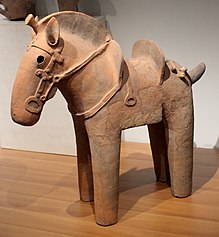
The Kofun period of Japanese history, from the 3rd to 6th centuries CE, is named after kofun, the often enormous keyhole-shaped Imperial mound-tombs, often on a moated island. None of these have ever been allowed to be excavated, so their possibly spectacular contents remain unknown.[72] Late examples which have been investigated, such as the Kitora Tomb, had been robbed of most of their contents, but the Takamatsuzuka Tomb retains mural paintings. Lower down the social scale in the same period, terracotta haniwa figures, as much as a metre high, were deposited on top of aristocratic tombs as grave markers, with others left inside, apparently representing possessions such as horses and houses for use in the afterlife.[73] Both kofun mounds and haniwa figures appear to have been discontinued as Buddhism became the dominant Japanese religion.[74]
Since then, Japanese tombs have been typically marked by elegant but simple rectangular vertical gravestones with inscriptions. Funerals are one of the areas in Japanese life where Buddhist customs are followed even by those who followed other traditions, such as Shinto. The bodaiji is a special and very common type of temple whose main purpose is as a venue for rites of ancestor worship, though it is often not the actual burial site. This was originally a custom of the feudal lords, but was adopted by other classes from about the 16th century. Each family would use a particular bodaiji over generations, and it might contain a second "grave" if the actual burial were elsewhere. Many later emperors, from the 13th to 19th centuries, are buried simply at the Imperial bodaiji, the Tsuki no wa no misasagi mausoleum in the Sennyū-ji temple at Kyoto.[75]
The Americas

Unlike many Western cultures, that of

The Jaina Island graves are noted for their abundance of clay figurines. Human remains within the roughly 1,000 excavated graves on the island (out of 20,000 total)[78] were found to be accompanied by glassware, slateware, or pottery, as well as one or more ceramic figurines, usually resting on the occupant's chest or held in their hands. The function of these figurines is not known: due to gender and age mismatches, they are unlikely to be portraits of the grave occupants, although the later figurines are known to be representations of goddesses.[79]
The so-called shaft tomb tradition of western Mexico is known almost exclusively from grave goods, which include hollow ceramic figures, obsidian and shell jewelry, pottery, and other items (see this Flickr photo for a reconstruction). Of particular note are the various ceramic tableaux including village scenes, for example, players engaged in a Mesoamerican ballgame. Although these tableaux may merely depict village life, it has been proposed that they instead (or also) depict the underworld.[80] Ceramic dogs are also widely known from looted tombs, and are thought by some to represent psychopomps (soul guides),[81] although dogs were often the major source of protein in ancient Mesoamerica.[82]
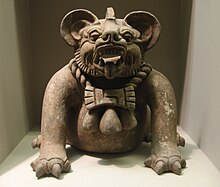
The Zapotec civilization of Oaxaca is particularly known for its clay funerary urns, such as the "bat god" shown at right. Numerous types of urns have been identified.[84] While some show deities and other supernatural beings, others seem to be portraits. Art historian George Kubler is particularly enthusiastic about the craftsmanship of this tradition:
No other American potters ever explored so completely the plastic conditions of wet clay or retained its forms so completely after firing ... [they] used its wet and ductile nature for fundamental geometric modelling and cut the material, when half-dry, into smooth planes with sharp edges of an unmatched brilliance and suggestiveness of form.[85]
The Maya

The earliest colonist graves were either unmarked, or had very simple timber headstone, with little order to their plotting, reflecting their
Traditional societies
There is an enormous diversity of funeral art from traditional societies across the world, much of it in perishable materials, and some is mentioned elsewhere in the article. In traditional African societies,
In several cultures, goods for use in the afterlife are still interred or cremated, for example
Funerary art and religion
Hinduism
Cremation is traditional among Hindus, who also believe in reincarnation, and there is far less of a tradition of funerary monuments in Hinduism than in other major religions.[96] However, there are regional, and relatively recent, traditions among royalty, and the samādhi mandir is a memorial temple for a saint. Both may be influenced by Islamic practices. The mausoleums of the kings of Orchha, from the 16th century onwards, are among the best known. Other rulers were commemorated by memorial temples of the normal type for the time and place, which like similar buildings from other cultures fall outside the scope of this article, though Angkor Wat in Cambodia, the most spectacular of all, must be mentioned.
Buddhism
Buddhist tombs themselves are typically simple and modest, although they may be set within temples, sometimes large complexes, built for the purpose in the then-prevailing style. According to tradition, the remains of the
Christianity

The

Christians believed in a bodily
If only because its strong prejudice against free-standing and life-size sculpture,
The
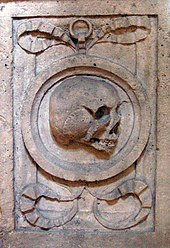
In the late Middle Ages, influenced by the
The church struggled to eliminate the pagan habits of leaving grave goods except for the clothing and usual jewellery of the powerful, especially rings. Kings might be buried with a
From the early 13th century to the 16th, a popular form of monument north of the Alps, especially for the smaller landowner and merchant classes, was the monumental brass, a sheet of brass on which the image of the person or persons commemorated was engraved, often with inscriptions and an architectural surround. They could be on the floor or wall inside a church. These provide valuable evidence as to changes in costume, especially for women. Many bishops and even some German rulers were commemorated with brasses.[114]
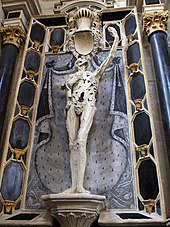
The
For some time after the
The large
By the 19th century, many Old World churchyards and church walls had completely run out of room for new monuments, and cemeteries on the outskirts of cities, towns or villages became the usual place for burials.[121] The rich developed the classical styles of the ancient world for small family tombs, while the rest continued to use gravestones or what were now usually false sarcophagi, placed over a buried coffin. The cemeteries of the large Italian cities are generally accepted to have outdone those of other nations in terms of extravagant statuary, especially the Monumental Cemetery of Staglieno in Genoa, the Cimitero Monumentale di Milano and the Certosa di Bologna.[122] In Italy at least, funerary sculpture remained of equal status to other types during the 19th and early 20th centuries, and was made by the leading artists, often receiving reviews in the press, and being exhibited, perhaps in maquette form.[123]
Monuments kept up with contemporary stylistic developments during the 19th century, embracing Symbolism enthusiastically, but then gradually became detached from the avant-garde after Art Nouveau and a few Art Deco examples.[124] Where burials in church crypts or floors took place, memorial stained glass windows, mostly on normal religious subjects but with a commemorative panel, are often found. War memorials, other than on the site of a battle, were relatively unusual until the 19th century, but became increasingly common during it, and after World War I were erected even in villages of the main combatant nations.[125]
Islam
Islamic funerary art is dominated by architecture. Grave goods are discouraged to the point that their absence is frequently one recognition criterion of Muslim burials.[126] Royalty and important religious figures were typically buried in plain stone sarcophagi, perhaps with a religious inscription. However, funerary architecture often offered a means of "moving beyond the strictures of formal Muslim burial rites" and expressing social dimensions such as status, piety, love for the deceased, and Muslim identity.[127]
A number of distinct architectural traditions arose for expressing these social elements. The Islamic tradition was slow in starting; the
Another influence may have been the octagonal
In all this tradition, the contemporary architectural style for mosques was adapted for a building with a smaller main room, and usually no courtyard. Decoration was often tilework, and could include
The tradition evolved differently in the
Other parts of the Islamic world reflected local techniques and traditions. The 15th-century royal
Contemporary period
Funerary art tends to be conservative in style, and many grave markers in various cultures follow rather traditional patterns, while others reflect
Several critics detect a crisis in public memorial style from 1945, when the traditional figurative symbolic language, and evocation of nationalist values, came to seem inadequate, especially in relation to
Many large mausoleums have been constructed for political leaders, including
See also
Notes
- ^ See for example the chapter "Tombs for the Living and the Dead", Insoll 176–87.
- mass burials (along with a set of primary remains) at Cuello, Belizeas "human grave goods".
- Banister Fletcher's A History of Architecture.
- ^ "funerary". Oxford English Dictionary (Online ed.). Oxford University Press. (Subscription or participating institution membership required.)
- ISBN 978-1900289-870.
- ^ Cockerham, Paul (2008). "Reformation, reaction, reception: a 21st-century view of monumental destruction". Church Monuments. 23: 137–41 (137).
- ^ Hoa Hakananai'a British Museum, accessed 26 April 2010
- ^ Toynbee, 47–48, on Ancient Rome. Stewart and Rawski's book is entirely devoted to Chinese ancestor portraits. See Chapter 1 etc.
- Nevali Cori in Turkey contains burials, Göbekli Tepeappears not to.
- ^ Mohen, 70
- ^ Mohen, 87
- ^ Kipfer, "Menhir", 348
- ^ Stone Circles of Senegambia – UNESCO World Heritage Centre, accessed 28 April 2010
- ^ Groenewegen-Frankfort, 80
- ^ Stone, 37
- ^ Kampen et al, 31
- ^ Maspero, 111–27, with serdabs 124–25
- ^ Robins, 51–55, 66–71, 218–19, and see index for other periods. Tomb styles changed considerably over the course of Egyptian history.
- ^ Spanel, 23
- ^ Atiya and El Shawahy, 73
- ^ Boardman, Edwards et al, 688–89
- ^ James, 122
- ^ Robins, 74
- ^ Boardman, 212, 15
- ^ Oakes and Gahlin, 236
- ^ Boardman, 26 and passim
- ^ Richter, 57
- ^ Henderson, 135
- ^ Wright, 391
- ^ Boardman, 212–13
- ^ Boardman, 149–50
- ^ Boardman, 151–54, and throughout the section on the period
- Mausoleum of Halicarnassus article, there are several from Lethaby's 1908 work here, and one illustrated in Boardman.
- ^ Boardman, 126–27
- ^ Boardman, 172–73, 339–44
- ^ Holiday, 73
- ^ de Grummond 1997, 359
- ^ de Grummond 2006, 231
- ^ de Grummond 1997, 93
- ^ Johnston, 489
- ^ a b c Davies, 632
- ^ Toynbee, Chapter I
- ^ Hall, 15
- ^ Toynbee, 39–40
- ^ Toynbee, Chapter IV; Hall, 53
- ^ Toynbee, 38
- ^ Toynbee, 31 (illustration)
- ^ Hall, 15, 35, 78
- ^ Petersen, 95–105; see also Boardman, 240–41 on Eurysaces' tomb.
- ^ Boardman, 339
- ^ Boardman, 339–44; Hall, 78–80
- ^ Hall, 54–61
- ^ Hall, 77–82
- ^ See for example Merriman, 297
- ^ Sickman and Soper, 57–66; see also the diagram here
- ^ Sickman and Soper, 155
- ^ Evasdottir, 158–60
- ^ Wu Hung, The Wu Liang Shrine: The Ideology of Early Chinese Pictorial Art (Stanford UPP, 1989))
- ^ Sickman and Soper, 77–84
- ^ Sickman and Soper, 120–21
- ^ Dien, 214–15
- ^ Sickman and Soper, 376 (illustrated)
- ^ Jeehee Hong, "Virtual Theater of the Dead: Actor Figurines and Their Stage in Houma Tomb No.1," Artibus Asiae Vol. 71–1, 2011
- ^ Thorp & Vinograd, 144
- ^ Goldin, 548
- ^ Brown, 44
- ^ UNESCO, Preservation of the Koguryo Kingdom Tombs, 24
- ^ Lee, 64
- ^ UNESCO, Preservation of the Koguryo Kingdom Tombs, 4
- ^ Park 33–34
- ^ Unesco Royal Tombs of the Joseon Dynasty.
- ^ Paine and Soper, 287–89
- ^ Paine and Soper, 24–26, 280–82
- ^ Paine and Soper, 289. See also List of National Treasures of Japan (archaeological materials)
- ^ Hall, John Whitney, 381–86
- ^ Smithsonian.
- ^ Chase and Chase, Chapter 3, especially p. 34
- ^ Muren.
- ^ Kubler, 266
- ^ See Taylor for discussion.
- ^ Coe et al., 103–04, or Mason, 182. In Richardson, 48–49 ("The dog, among the Maya, was considered to be connected with death, and to be the messenger to prepare the way to the hereafter.")
- ^ Coe, 45 ("The only domestic animals were dogs—the principal source of meat for much of Preclassic Mesoamerica—and turkeys—understandably rare because that familiar bird consumes very large quantities of corn and is thus expensive to raise".)
- ^ Height: 9.5 in (23 cm). "The Bat God was one of the important deities of the Maya, many elements of whose religion were shared also by the Zapotec. The Bat God in particular is known to have been revered also by the Zapotec ... He was especially associated ... with the underworld." Mason, 182. In Richardson, 48–49
- ^ Kubler, 163
- ^ Kubler, 164
- ^ Giammattei and Reichert, 3. Cited in the Introduction to The Mimbres of the Mogollon culture: A people of mystery by Andrew Gulliford
- ^ Mounds & Mound Builders Archived 23 June 2008 at the Wayback Machine Accessed 25 April 2010
- ^ Dethlefsen; Deetz (1966) p. 508
- ^ Hijiya (1983), pp. 339–63
- ^ Masks in West African Traditional Societies, Bonnefoy, pp. 133–37
- ^ Davies, Serena (23 August 2004). "Viewfinder: Aboriginal burial poles". The Daily Telegraph. London. Retrieved 21 April 2010.
- ^ Oxenham.
- ^ "Kasubi tombs website". Archived from the original on 23 March 2010. Retrieved 21 April 2010.
- ISBN 978-1-60413-097-3.
- ^ British Museum: Modern coffin in the shape of an eagle, from Ghana. Accessed 22 March 2010
- ^ Groseclose, 23
- ^ Le Phuoc, 140–42; 147–56 on Sanchi; 192–204, especially 196, on candi in Indonesia, and Borodudur (196–204)
- ^ Dowman, 54–55 for the Potala, and see index for other locations.
- ^ Syndicus, Chapter 1; Hall, 77–82
- ^ Syndicus, 39, 72–90
- ^ Toynbee, 48–49.
- Cremation in the Christian World for more details—the Orthodox churchesstill forbid cremation.
- ^ Board of Trustees for The Hofkirche in Innsbruck.
- ^ Welch, 26
- ^ Downey.
- ^ Levey 1967, 57–59
- Gothic revival monuments like the Albert Memorial and the Scott Monument, neither containing a tomb.
- ^ Hall, 325
- ^ Cohen throughout, see Introduction
- ^ Hall, 324–26
- ^ Piponnier and Mane, 112–13
- ^ Bloxham, Jim and Rose, Krisine; St. Cuthbert Gospel of St. John, Formerly Known as the Stonyhurst Gospel Archived 26 July 2011 at the Wayback Machine
- ^ Piponnier and Mane, 34–35; 112–13
- ^ "Brasses, Monumental"
- ^ The corpse was in fact not always present. Bagliani, 158–59
- ^ Piponnier and Mane, 113 for the origins of mourning clothes.
- ^ See for example Michalski, xi. Here Michalski refers to this rejection of religious imagery within Calvinism as "iconophobia". See also Gäbler, 72, 76–77 and Potter, 130–31 regarding the religious disputations in Zürich (1523) concerning (among other things) the removal of statues of saints and other icons. Participants included Leo Jud and Huldrych Zwingli.
- ^ The Saltonstall Family is a well-known example. The Arnolfini Portrait has been claimed to be such a work
- ^ Hall, 324–27
- ^ Hall, 347–49; Berresford, 36–38
- ^ "Cemetery"
- ^ Berresford, throughout, and Prefaces
- ^ Berresford, 13, and 58 on exhibitions
- ^ Berresford, 77–78 on "Liberty" (Italian term for "Art Nouveau") and 99–104 on Art Deco.
- ^ Mosse, Chapter 5
- ^ Insoll, 172
- ^ Insoll, 177–80
- ^ Ruggles, 103
- ^ Ruggles, 103–04
- ^ Ruggles, Chapter 9
- ^ Ruggles, 104
- ^ a b Insoll, 177
- ^ Ruggles, 112 and 122. Her Chapter 10 includes a detailed description of the Taj with special reference to its gardens.
- ^ An interesting contrast with the Taj Mahal, given they were both built by Shah Jahan.
- ^ a b The New York Times, Khomeini's Tomb Attracts Pilgrims, Philip Shenon, Published: 8 July 1990, accessed 25 April 2010.
- ^ Levey 1975, 29–33 on Bursa, 83–84 on Istanbul; all the leading Ottoman tombs are covered in the book.
- ^ Tomb of Askia, UNESCO page with aerial view.
- madrassais labeled "the ultimate achievement of architectural development in Cairo" and its tomb chamber described as "immense."
- ^ Mosse, 103–06 on conservatism, and generally throughout Chapter 5 on war memorials.
- ^ Mosse, 97–98; Carrier, 201
- ^ "Japan wants talks with China, Korea on Yasukuni Shrine", Associated Press story, South China Morning Post website, 6 January 2014, accessed 4 May 2015
- ^ Carrier, 19–22; Benton throughout, especially p. 194.
- ^ Benton throughout, especially Chapter 1 on Soviet War Memorials (pp. 12–13 on Socialist Realism), but also noting deviations in the Warsaw Pact satellites, as on p. 194, and Chapter 7 on West Germany.
- ^ Carrier, throughout, especially Chapter 8. See also the copious literature on the Washington Vietnam Veterans Memorial.
References
- Atiya, Farid and El-Shahawy, Abeer. The Egyptian Museum in Cairo: A Walk Through the Alleys of Ancient Egypt. American University in Cairo Press, 2005. ISBN 977-17-2183-6
- Bagliani, Agostino Paravicini. The Pope's Body University of Chicago Press, 2000, ISBN 978-0-226-03437-9
- Benton, Charlotte (ed). Figuration/Abstraction: Strategies for Public Sculpture in Europe, 1945–1968, Ashgate Publishing, Ltd., 2004, ISBN 978-0-7546-0693-2
- Berresford, Sandra, et al. Italian Memorial Sculpture, 1820–1940: a Legacy of Love, Frances Lincoln Ltd, 2004, ISBN 978-0711223844
- Board of Trustees for The Hofkirche in Innsbruck. "The Memorial Tomb for Maximilian I", 2005. Accessed 22 March 2010.
- ISBN 0-19-814386-9
- Boardman, John; Edwards, I. E. S.; Sollberger, E. and N. G. L. Hammond, eds. The Cambridge Ancient History, Volume 3, Part 2: The Assyrian and Babylonian Empires and Other States of the Near East, from the Eighth to the Sixth Centuries BC. Cambridge University Press; 2nd ed., 1992. ISBN 0-521-22717-8
- Bogucki, Peter I. The origins of human society, Wiley-Blackwell, 1999, ISBN 978-1-57718-112-5
- Bonnefoy, Yves. American, African, and Old European mythologies, University of Chicago Press, 1993, ISBN 978-0-226-06457-4
- "Brasses, Monumental". Encyclopædia Britannica. Volume IV (11th ed.). New York: Encyclopædia Britannica, 1911, 434.
- Brown, Miranda. The Politics of Mourning in Early China. State University of New York Press, 2007. ISBN 0-7914-7157-8
- Carrier, Peter. Holocaust monuments and national memory cultures in France and Germany since 1989: the origins and political function of the Vél' d'Hiv' in Paris and the Holocaust Monument in Berlin, Berghahn Books, 2006, ISBN 978-1845452957
- "Cemetery". Merriam-Webster's Encyclopedia of World Religions. Merriam-Webster, 1999, 191–92
- Chase, Diane Z. and Chase, Arlen F., Mesoamerican Elites: An Archaeological Assessment, University of Oklahoma Press, 2003, ISBN 978-0-8061-3542-7
- ISBN 0-8160-1199-0
- Coe, Michael. Mexico, from the Olmecs to the Aztecs. Thames and Hudson, 1994. ISBN 0-500-27722-2
- Cohen, Kathleen. Metamorphosis of a death symbol: the transi tomb in the late Middle Ages and the Renaissance, University of California Press, 1973, ISBN 978-0-520-01844-0
- Davies, Glenys. "The Significance of the Handshake Motif in Classical Funerary Art". American Journal of Archaeology, Volume 89, No. 4, 1985. 627–40
- de Grummond, Nancy Thomson. Etruscan Italy today. In Hall, John Franklin (ed.) Etruscan Italy: Etruscan Influences on the Civilizations of Italy from Antiquity to the Modern Era. Indiana University Press, 1997. ISBN 0-8425-2334-0
- de Grummond, Nancy Thomson. Etruscan Myth, Sacred History, And Legend. University of Pennsylvania Museum Publication, 2006. ISBN 1-931707-86-3
- Dethlefsen, Edwin; Deetz, James. "Death's Heads, Cherubs, and Willow Trees: Experimental Archaeology in Colonial Cemeteries". American Antiquity, 1966
- Dien, Albert E. Six dynasties civilization. Early Chinese civilization series. Yale University Press, 2007. ISBN 0-300-07404-2
- Dowman, The power-places of Central Tibet: the pilgrim's guide, Routledge, 1988, ISBN 978-0-7102-1370-9
- Downey, Glanville. "The Tombs of the Byzantine Emperors at the Church of the Holy Apostles in Constantinople". The Journal of Hellenic Studies, Volume 79, 1959. 27–51.
- El-Shahawy, Abeer. Funerary Art of Ancient Egypt. American University in Cairo Press, 2005. ISBN 977-17-2353-7
- Evasdottir, Erica E. S. Obedient Autonomy: Chinese Intellectuals And The Achievement Of Orderly Life, UBC Press, 2005, ISBN 978-0-7748-0930-6
- Fletcher, Banister and Cruickshank, Dan. Sir Banister Fletcher's a history of architecture. 20th ed. Oxford: Architectural Press, 1996. ISBN 0-7506-2267-9
- Gäbler, Ulrich. Huldrych Zwingli: His Life and Work. Philadelphia: Fortress Press, 1986. ISBN 0-8006-0761-9
- Gargett, Robert H. "Middle Palaeolithic burial is not a dead issue: the view from Qafzeh, Saint-Césaire, Kebara, Amud, and Dederiyeh". Journal of Human Evolution, Volume 37, 1999. 27–90 (accessed, 6 April 2010)
- Giammattei, Victor Michael and Reichert, Nanci Greer. Art of a Vanished Race: The Mimbres Classic Black-On-White. Silver City NM: High Lonesome Books, 1998. ISBN 0-944383-21-1
- Goldin, Paul R. "The Motif of the Woman in the Doorway and Related Imagery in Traditional Chinese Funerary Art." Journal of the American Oriental Society, Volume 121, No. 4, 2001.
- Groenewegen-Frankfort, H. A. Arrest and Movement: An Essay on Space and Time in the Representational Art of the Ancient Near East. Belknap Press / Harvard University Press, 1987. ISBN 0-674-04656-0
- Groseclose, Barbara. British Sculpture and the Company Raj: Church Monuments and Public Statuary in Madras, Calcutta, and Bombay to 1858, University of Delaware Press, 1995. ISBN 0-87413-406-4.
- Hall, James. A History of Ideas and Images in Italian Art. London: John Murray, 1983. ISBN 0-7195-3971-4
- Hall, John Whitney ed. The Cambridge History of Japan: Early modern Japan, Cambridge University Press, 1991. ISBN 0-521-22355-5
- ISBN 0-88402-252-8. Accessed 22 March 2010.
- Henderson, Jeffrey. "The Lekythos and Frogs 1200–1248". Harvard Studies in Classical Philology, Volume 76, 1972. 133–43
- Holiday, Peter J. "Processional Imagery in Late Etruscan Funerary Art." American Journal of Archaeology, Volume 94, No. 1, 1990. 73–93
- Insoll Timothy. The Archaeology of Islam. Wiley-Blackwell, 1999. ISBN 0-631-20115-7
- James, T.G.H., The British Museum Concise Introduction to Ancient Egypt. University of Michigan Press, 2005. ISBN 0-472-03137-6
- Johnston, Sarah Iles. Religions of the Ancient World: A Guide. Belknap Press (Harvard University Press Reference Library), 2004. ISBN 0-674-01517-7.
- Kampen, Nathalie Boymel; Bergman, Bettina; Cohen, Ada and Eva Steh. Sexuality in Ancient Art. London: Cambridge University Press, 1996. ISBN 0-521-47683-6
- Kipfer, Barbara Ann. Encyclopedic dictionary of Archaeology, Springer, 2000. ISBN 978-0-306-46158-3
- ISBN 0-300-05325-8
- Lee, Ki-Baik A New History of Korea. Harvard University Press, 1984. ISBN 0-674-61576-X
- ISBN 0-500-27065-1
- Levey, Michael. Early Renaissance. Penguin Books Ltd. 1991. ISBN 0-14-013756-4
- Mason, J. Alden. "Zapotec Funerary Urns from Mexico", The Museum Journal, University of Pennsylvania, Volume 20, 1929. 176–201
- ISBN 978-3-86195-096-7
- Ludwig, Allen I. (2000). "Graven Images: New England Stone Carving and its Symbols, 1650–1815". CT: ISBN 978-0-8195-6040-7
- Ludwig, Allen I. (2000). "Graven Images: New England Stone Carving and its Symbols, 1650–1815". CT:
- Merriman, Nick. Public Archaeology. London: Routledge, 2004. ISBN 0-415-25889-8
- Michalski, Sergiusz. The Reformation and the Visual Arts: The Protestant Image Question in Western and Eastern Europe. London: Routledge, 1993. ISBN 0-415-06512-7
- Mohen, Jean-Pierre. The World of Megaliths. New York: Facts on File, 1990. ISBN 0-8160-2251-8
- Mosse, Fallen Soldiers: Reshaping the Memory of the World Wars. Oxford University Press US, 1991. ISBN 978-0-19-507139-9
- Muren, Gladys "Jaina Standing Lady", Utah Museum of Fine Arts. Accessed 22 April 2010.
- Oakes, Lorna and Gahlin, Lucia. Ancient Egypt: An Illustrated Reference to the Myths, Religions, Pyramids and Temples of the Land of the Pharaohs. Hermes House, 2002. ISBN 1-84477-008-7
- Oxenham, Marc F.; Tom Knight and Michael Westaway. "Identification of Australian Aboriginal Mortuary Remains". in Marc Oxenham. Forensic Approaches to Death, Disaster and Abuse. Bowen Hills QLD: Australian Academic Press, 2008, pp. 37–54. ISBN 978-1-875378-90-6
- Paine, Robert Treat, and ISBN 0-14-056108-0
- ISBN 978-0-8109-3870-0
- Park, Changbom. Astronomy: Traditional Korean Science. Ewha Womans University Press, 2008. ISBN 89-7300-779-3
- Petersen, Lauren Hackworth. The Freedman in Roman art and art history, Cambridge University Press, 2006, ISBN 978-0-521-85889-2
- Pettitt, Paul. When Burial Begins Archived 2 June 2007 at the Wayback Machine, British Archaeology, Issue 66, August 2002.
- Phuoc, Le Huu Buddhist Architecture, Grafikol, 2010, ISBN 978-0-9844043-0-8
- Piponnier, Françoise and Mane, Perrine. Dress in the Middle Ages; 151, Yale UP, 1997. ISBN 0-300-06906-5
- Potter, G. R. Zwingli. Cambridge: Cambridge University Press, 1976. ISBN 0-521-20939-0
- Prioli, Carmine. "Review: Early New England Gravestone Scholarship". Early American Literature, Volume 14, no. 3, Winter, 1979/1980
- Richardson, E. P. "Zapotec Pottery Sculpture". Parnassus, Volume 4, No. 3, 1932. 48–49
- Richter, Gisela M. A. "A Newly Acquired Loutrophoros". The Metropolitan Museum of Art Bulletin, Volume 23, No. 2, Part 1, 1928. 54–57
- Robins, Gay. The Art of Ancient Egypt. Harvard University Press, 2000. ISBN 0-674-00376-4
- Ruggles, D. Fairchild. Islamic gardens and landscapes, University of Pennsylvania Press, 2008, ISBN 978-0-8122-4025-2
- ISBN 0-14-056110-2
- Smithsonian National Museum of the American Indian. Born of Clay: Ceramics from the National museum of the American Indian. NMAI Editions, 2005. ISBN 1-933565-01-2.
- Spanel, Donald B. Through Ancient Eyes: Egyptian Portraiture. 2nd. Birmingham, Alabama: Birmingham Museum of Art, 1988.
- Stone, K. Image and Spirit: Finding Meaning in Visual Art. Minneapolis, MN: Augsburg Books, 2003.
- Stuart, Jan and Rawski, Evelyn Sakakida. Worshiping the ancestors: Chinese commemorative portraits, Stanford University Press, 2001, ISBN 978-0-8047-4263-4
- Syndicus, Eduard; Early Christian Art; Burns & Oates, London, 1962
- Taylor, R. E. "The Shaft Tombs of Western Mexico: Problems in the Interpretation of Religious Function in Nonhistoric Archaeological Contexts." American Antiquity, Volume 35, No. 2, 1970. 160–69
- Thorp, Robert L. and Vinograd, Richard Ellis. Chinese Art and Culture. Prentice Hall, 2003. ISBN 0-13-183364-2
- Toynbee, Jocelyn M. C. Death and Burial in the Roman World, JHU Press. 1996. ISBN 0-8018-5507-1
- UNESCO, Preservation of the Koguryo Kingdom Tombs, 2005. (PDF)
- Welch, Evelyn. Art in Renaissance Italy, 1350–1500. Oxford: Oxford University Press, 2000. ISBN 0-19-284279-X
- Wright, John Henry. "Unpublished White Lekythoi from Attika." The American Journal of Archaeology and of the History of the Fine Arts, Volume 2, No. 4, 1886. 385–407
Further reading
- ISBN 978-0-7134-7336-0.
- ISBN 9780714828244.
External links
- Islamic tombs and shrines, from the United States Naval academy
- Handbook for identification and repair of monuments


